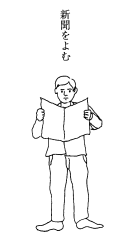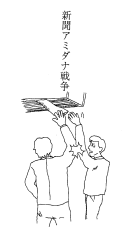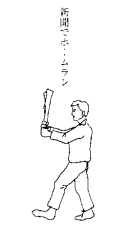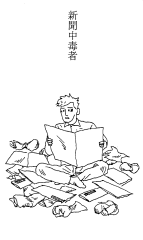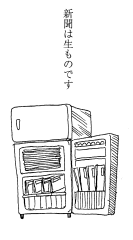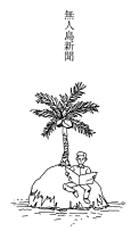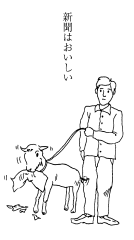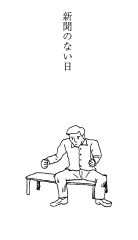To Our Readers
We are pleased to announce that with this November issue, NSK News Bulletin Online has entered its second year of publication. We greatly appreciate your continued support.
More than ever, we are working hard to ensure that the bulletin responds to your needs. To this end, we invite you to send your comments and requests to the editor of NSK News Bulletin Online at editor@pressnet.or.jp
Thank you.
|
NSK News Bulletin Online
Nov. 2002
Newspaper Convention Hears Call for Quality to Reverse Readership Decline
The 55th National Newspaper Convention was held on Oct. 17-18 at Nagoya Congress Center in Nagoya City, Aichi Prefecture. Starting in the morning with a ceremony for the recipients of this year°«s NSK Awards, the convention then heard the keynote speech, °»What Is Wisdom in the 21st Century,°… by the 2001 Nobel Prize-winner for chemistry, Nagoya University Prof. Ryoji Noyori. The afternoon session continued with the lecture °»Ubiquitous Computing will Pave the Way for the Future°… by Ken Sakamura, professor of Interfaculty Initiative in information Studies at the Graduate School of the University of Tokyo.
After the lecture, senior executives of the Yomiuri, Nikkei, Sankei, Hokkaido and Chunichi newspapers held a panel discussion on °»How to Enhance the Attractiveness of Newspapers.°… Some of the panelists expressed worry about the recent trend of declining newspaper readership, noting that an increasing number of younger people do not read newspapers and citing the view that reading newspapers is no longer a requirement for being considered an intellectual adult.
The resulting heated debate generated a number of specific proposals on how to end the erosion of interest in newspapers:
°¶ Newspapers can be improved by overcoming the traditional reluctance to see them as commercial products
°¶ Reporters need to be reeducated to enhance public faith in newspapers
°¶ More community-based services need to be provided to readers
°¶Individual newspaper companies should display all aspects of their unique characteristics
°¶Returning to the core concept that advertising is itself news, new variations in newspaper-specific advertising should be developed.
On the issue of electronic publishing, the panelists shared the view that for the time being, print newspapers will continue to coexist with those offered over the Internet.
A number of special events are regularly associated with the National Newspaper Convention. This year, the prize-winning works from the °»Newspaper Photo Contest°… were put on display in Nagoya City and other events were held at four sites in the city from Oct. 16-20 as part of what was dubbed the °»Read Me Plaza in Nagoya°… campaign. In Tokyo, Osaka, Nagoya and Fukuoka, representatives of newspaper subscribers took part in memorial gatherings.
Oct. 20 is Newspaper Advertisement Day. As the day fell on a Sunday this year, the advertisement-related awards ceremony was moved forward to Oct. 18. The ceremony at the Palace Hotel in Tokyo honored the winners of this year°«s Newspaper Advertisement Prizes. °»Newspaper Delivery Day°… and °»Newspaper Delivery Boys Day°… were marked by various events held across the country to recognize the work of all those engaged in newspaper delivery and specifically of newspaper delivery boys and girls.
NSK °»Read Me°… Campaign Aimed at Younger Generations
(°»Read Me°… Campaign)
The three-year NSK °»Read Me°… campaign launched in fiscal 2000 has been aimed at encouraging younger generations to read newspapers. The start of the third year of the campaign was marked by the publication of a free booklet titled °»The Newspaper Book°… (see photo).
The A6-size booklet features 60 line-drawing illustrations of scenes linked to newspapers. Each illustration carries a short catchphrase based on the key word °∆newspaper°«. The booklet°«s combination of humorous phrases and images is designed to make young people feel more comfortable with having newspapers present in their personal lives. The newspaper industry faces a pressing task of trying to narrow the gap between youth and newspapers. Each newspaper company is also making its own efforts to arouse youth interest.
Copies of the °»Newspaper Book°… were given out to visitors to the °»Read Me Plaza in Nagoya°… events that began on Oct. 16. The booklet is also to be distributed as a freebie as a part of each newspaper company°«s own promotional activities and at seminars aimed at encouraging youth to subscribe to newspapers.
NSK has prepared newspaper advertisement materials, posters and logo designs that can be tailored to the particular specifications of each NSK member newspaper company°«s promotional and public relations activities within their own °»Read Me°… campaigns.
In August 2001, NSK launched a Web site exclusively dedicated to the °»Read Me°… campaign (http://www.readme-press.com/index.html) at which it solicits readers°« opinions about newspapers. In this third and final year of the campaign, NSK is to run a massive publicity drive in February through coordinated newspaper advertisements and radio commercials. It will urge youths to subscribe to newspapers through a series of black-and-white full-page newspaper ads and radio commercials carried by two nation-wide radio networks in the FM and AM radio bands, respectively. The radio commercials will be 20 seconds in duration and will air 20 times per month on each station. The main slogan of the drive will be, °»Are You Living a Live of Great Diversity?°… ? building on last year°«s slogan, °»It°«s Better to Lead a Life With Knowing Than To Do So Without Knowing.°… The campaign will be run in a manner based on mainly sending out the message through other forms of media.
Seitaro Okada, the chief of the NSK Newspaper PR Division, says he is ambitious about the planned campaign. He says he aims to make subscribers of those many young people who might have had their hands on a newspaper, but who have never read one for more than five minutes.
|
|
|
|
|
|
|
|
Reading a newspaper |
|
Scrambling to get a newspaper left on a train rack |
|
Crack a round-tripper with a newspaper-made bat |
|
|
|
|
|
|
|
|
|
|
A mobile newspaper |
|
A newspaper addict |
|
Newspaper is perishable |
|
|
|
|
|
|
|
|
|
|
Swept Away |
|
Newspaper is tasty |
|
The day when a newspaper is not available |
|
|
|
|
|
|
|
|
|
|
|
|
|
|
|
|
|
|
|
|
|
|
(Activities by Each Newspaper Company)
Each newspaper company is using a mix of the Internet and other types of media to conduct sales-promotion activities aimed at soliciting subscriptions from younger generations.
For instance, the Tokyo head office of the Asahi Shimbun in September 2001 set up a °»Committee to Nurture Future Readers°… composed of staff members from the circulation, editorial, publicity/PR and marketing divisions. This past October, additional staff members from the advertisement, electronic and TV/radio divisions joined the committee to study what approach might be most effective in reaching the target groups of adults, university students, high school students and other younger people.
The Mainichi Shimbun in April of this year set up a PR secretariat within the president°«s office in the aim of reinforcing PR activities for its own newspaper. The new office is to strive to get its message to younger generations by soliciting ideas from Mainichi employees. In October, the Mainichi launched TV commercials with its newspaper in Braille as a motif. The company is using the theme of °»tenderness,°… focusing on its 80 years of publishing its Braille edition.
The Yomiuri Shimbun is concentrating on the importance of preserving a culture of printed media, noting that the younger generation°«s tendency not to read could ultimately undermine creative thinking and creativity in general in future generations. The Yomiuri plans to hold eight gatherings of a °»21st Century Printed Culture Forum°… through November 2004. It will also launch publicity drives encouraging children to read books and organizing lectures for citizens in cooperation with universities and libraries. Linked with newspaper articles and the contents on the newspaper°«s own Web site, the Yomiuri°«s efforts are intended to familiarize children, youths and others with the printed-media culture.
The Nikkei believes that the annual seasons for admission to university, job-hunting by graduating students and entrance into company employment are main times at which youths are likely to start reading newspapers. As a result, the Nikkei is timing its promotional activities to match those seasons. Nikkei is proposing that universities use newspapers as educational materials for ordinary study courses and seminars. Upon request, it sends staff members to give lectures or to provide guidance at job-hunting meetings. The lecturers teach students how to read and make best use of the Nikkei°«s daily paper. The Nikkei says freshmen and sophomores can learn the basics of economics by reading the Nikkei daily, which it claims is also useful as a reference for students choosing their future occupation. It is offering new subscribers from among university students and new company employees an easy-to-understand free booklet on how to read the Nikkei and interpret basic economic data. Kenji Suzuki, a deputy circulation manager and chief of the marketing development division, says, °»With the admission to university as a starting point, we are expecting our readers to become life-long subscribers, even in their post-retirement years.°…
The Shinano-Mainichi is teaming up with local operators of wedding halls to promote a °»bridal campaign.°… The wedding hall operators solicit subscriptions from, or offer trial readings of the newspaper to couples booking the halls. Those who subscribe receive a laminated front page of the newspaper on the day of their wedding.
Various other attempts are being made to raise youth interest in newspapers, including the publication of a PR magazine targeted at students and young women and the presentation on newspaper pages of features linked to informational magazines issued by non-newspaper publishers.
For instance, the Asahi°«s Tokyo head office sponsored a music program for youth on the FM radio station J-Wave from April 1999 through March of this year. The program included a regular message urging listeners to subscribe to newspapers, and the program°«s DJ in turn contributed a column to the daily newspaper.
The Nishi-Nippon is attempting to create newspaper pages together with subscribers who have offered to participate, by linking pages exclusively for youth to its Web site.
|
|
Japan-South Korea Editors Seminar Deepens Mutual Understanding
The Japan-South Korea Editors Seminar was held at the Japan National Press Center Hall in Tokyo°«s Uchisaiwai-cho on Oct. 30. It was the 39th such meeting held since the normalization of bilateral diplomatic relations in 1966.
A total of 15 representatives from 15 South Korean media companies and 13 representatives from 12 Japanese companies took part. With Japan-South Korea relations after the co-hosting of the soccer World Cup and the new situation in Northeast Asia as the main subjects, the participants candidly exchanged views on the latest developments in the normalization negotiations between Japan and North Korea and on the issue of North Korea°«s abductions of Japanese nationals.
The seminar began with keynote speeches by Kim Tae Il, the chief of the cultural affairs division of the Chosun Ilbo, and by Yuji Yamamoto, a deputy chief of the foreign news division of the Tokyo Shimbun. Free discussion ensued.
Kim spoke of the major changes in the newspaper coverage of South Korea-Japan relations since the co-hosting of the World Cup. He said there were substantial changes in South Korean newspaper coverage of the days marking the liberation of Korea from Japan°«s colonial rule (August 15) and the commencement of Japan°«s colonial rule upon its annexation of Korea (August 29).
Kim said it had been customary on such memorial days for South Korean media to publish articles emphasizing the brutality of the Japanese and how the Korean people rose up against Japanese rule. But the Chosen Ilbo did not carry any anniversary articles appealing to such national sentiments this year, he said, adding that even more importantly, the daily newspaper did not receive any protests from readers about the absence of such articles.
Kim said that the successful co-hosting of the World Cup brought about what he described as a °»new and open nationalism°… in South Korea. °»South Korea°«s traditional nationalism was of a closed nature, arising from the bitter experiences of having been ruled by a foreign country, which has been an impediment to progress in South Korea-Japan relations. However, that nationalism has been transformed into a new and non-exclusive one, as shown by youths wearing their national flags like cloaks while watching World Cup games. That change will be an important force for the new development of South Korea-Japan relations,°… he said.
Further, Kim noted the recent phenomenon of the Japanese film °»Love Letter°… becoming a major hit in South Korea. He concluded his speech by saying South Korea-Japan relations will make further progress when each person strives to feel sympathy and affection with respect to the specific things that affect the other country°«s individuals, and strives to find real emotion and humanism in those feelings.
In his keynote speech, Yamamoto referred to the deepening of mutual Japan-South Korea understanding resulting from the co-hosting of the World Cup. He acknowledged the positive results of South Korean President Kim Dae Jung°«s phased liberalization of the introduction into South Korea of Japanese popular culture. He said that it is particularly important to promote exchanges between the two countries°« younger generations. He also said that journalists must in turn become accustomed to reporting the attractiveness and appeal of each country°«s society and culture.
On the issue over Japan°«s history textbooks, Yamamoto said that Japan should tolerate South Korean criticism of the problems involving Japanese textbooks. However, he said he doubted the wisdom of South Korea°«s application of diplomatic pressure on Japan by resorting to temporarily recalling its ambassador and suspending bilateral exchange projects in various fields. °»Just as it seeks Japan°«s unbiased recognition of the historical past, South Korea should be expected to become more lenient in accepting the freedom of expression in Japan,°… he said.
During the free discussions in the afternoon session, Lee Ki Chang, deputy managing editor and sports editor at the Korea Ilbo, returned to the textbook issue and said that it is important to pass on historical truths to younger generations and that the matter should not be given preference to the freedom of expression. Responding to Lee°«s assertion, Yamamoto said that mutual understanding of the differences of each country°«s textbooks in terms of types and descriptions should be deepened to pave the way for joint research.
On other issues, Bungo Osawa, deputy chief of the foreign news division at the Mainichi Shimbun°«s Tokyo head office, brought up the fact that a large number of young South Korean intellectuals have obtained master°«s degrees in diverse fields at Japanese universities. But he said that many of these youths, who were expected to serve as a bridge to narrow differences between the two countries, are reportedly unable to obtain decent jobs. Osawa said that efforts should be made to make the most use of these human resources. He also called on the media to provide incentives for each country to learn from the other country.
On the matter of normalization talks between Japan and North Korea, Ahn Sang Yun, a commentator at Seoul Broadcasting Station (SBS), suggested that Japan had better get accustomed to North Korea°«s way of communicating. According to An, North Korea uses its talent in rhetoric to dramatic effect when pressed hard to break a deadlock. North Korea admitted its responsibility in the abduction case and its continued development of nuclear weapons in an apparent bid to enter into dialogue with Japan, he said, adding that behind North Korea°«s diplomatic overture lies its severe economic situation. Some Japanese participants responded by saying that North Korea should also get accustomed to the prevailing manner of communications in the international community.
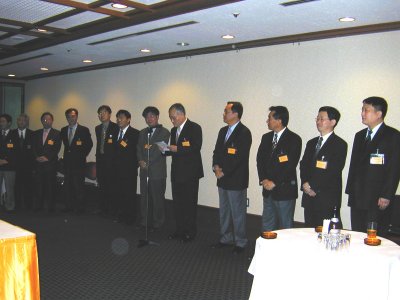
Norio Sugawara, chief of the international division and editorial writer at the Hokkaido Shimbun°«s Tokyo office, noted that the White House, in its statement concerning Prime Minister Junichiro Koizumi°«s visit to Pyongyang, stopped short of supporting Japan°«s initiatives, ending up making nothing but an appraisal, even though the United States is Japan°«s ally. He said that Japan°«s Foreign Ministry had never thought that the United States would be so sensitive about the North Korea nuclear issue, adding that both Japan and North Korea might have misread the U.S. response. On this issue, Lee Kwang Sik an editorial writer for the Kangwon Domin Ilbo, commented that North Korea°«s inclination toward possessing nuclear weapons results from a need to block U.S. military attacks, rather than for a military campaign of its own, adding that over the medium and long term, he feels that the North Korean nuclear issue can be resolved peacefully.
After the free discussion, Tetsuro Yano, senior vice minister for foreign affairs, joined the debate as a special guest, exchanging views with the participants about the Foreign Ministry°«s posture on normalization talks with North Korea.
°°
Topics.......Topics.......Topics........
|
NSK conducts the Tokyo program of the Jefferson Fellowship for journalists
The Fall 2002 Jefferson Fellowship for journalists, sponsored by the East-West Center in Hawaii, held a workshop in Japan from Oct. 26 to Nov. 1. Thirteen journalists from 12 countries took part.
Since 1967, the fellowship has accepted about 400 journalists from 27 countries for training and travel for newsgathering activities with the aim of deepening the understanding of diverse issues in the Asia-Pacific area and the United States.
The Fall program began on Oct. 6 in Hawaii on the theme °»Responding to Recession.°… Following the opening session in Hawaii, the fellows visited Washington D.C. and Seattle, wrapping up the final week of the program with the workshop in Tokyo.
The fellows were briefed about Japan°«s economic stagnation sa well as political issues by reporters and other journalists from the Asahi, Yomiuri, Nikkei and Sankei newspapers, and had talks with Yasuhisa Shiozaki, a member of the House of Representatives, Hatsuhisa Takashima, press secretary of the Foreign Ministry, and others.
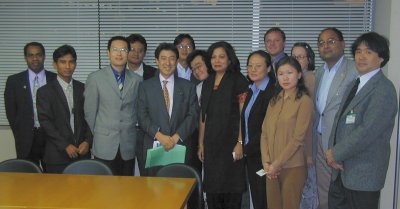 |
Jefferson fellows with Yasuhisa Shiozaki(fifth one from the end of thr left), a member of the House of Representatives
|
The Jefferson Fellows Fall 2002, Program
Burma (Myanmar) CHIT WIN MAUNG, Chief Editor, Yanantthit Magazine, Reader°«s Journal, Tet Lann Journal, Rangoon
Cambodia THET Sambath, Associate Editor, The Cambodia Daily, Phnom Penh
China YANG Shaoping, Reporter/Anchor, Chengdu Television
India Jaideep MISHRA, Assistant Editor, The Economic Times, New Delhi
Indonesia Ardian GESURI, Managing Editor, Kontan Weekly Economics & Business, Jakarta, DKI
Japan YASUDA Hideaki, Deputy Editor, Economic News Dept, The Tokyo Shimbun, Tokyo
Korea KANG Kyung-Hee, Staff Writer of Business & Technology Desk, Chosun Ilbo, Seoul
Mongolia Bekhbayar DAMDINDORJ, Journalist, Today, Ulaanbaatar City
Pakistan Shaheen SALAHUDDIN, Anchor/Reporter, Indus Vision Television, Karachi
Solomon Islands Walter NALANGU, Manager News & Current Affairs, Solomon Islands Broadcasting Corporation, [SIBC], Honiara
Taiwan LIN Wen-chi, Editor, Politics & Economy News Desk, The Commercial Times, Taipei
USA Carrie KIRBY, Business Reporter, San Francisco Chronicle, San Francisco
Glenn VAN ZUTPHEN, Producer/Anchor, CNN International, Atlanta
South Korean City News Editors Visit Japanese Counterparts
Eleven city news editors from South Korea°«s major newspapers and broadcasting stations held discussions on various issues with 10 city news editors from Tokyo-based major newspapers at the Japan National Press Club, in Tokyo, on Oct. 15. The visiting editors were on a fact-finding tour to Japan sponsored by the Korea Press Foundation.
On the issue of North Korea°«s abductions of Japanese nationals, the South Korean editors made some critical comments, including:
°¶Japanese media appear to be overreacting on the abductions issue. If Japan deliberately makes an issue of the case to try to influence negotiations with North Korea in Japan°«s favor, the ultimate result will be disadvantageous for Japan
°¶There is no denying the fact that complicated sentiment prevails in South Korea over North Korea°«s apology to Japan (for the abductions) at a time when Japan has still not yet settled the problem of its war responsibility
°¶Japan should promote dialogue with North Korea in the aim of ensuring peace in Northeast Asia, without continually returning to the problems of the past
°¶Japan should not miss this golden opportunity (to normalize relations with North Korea) at this time of a change of major significance in North Korea.
The Japanese editors responded with comments including:
°¶A majority of the Japanese public want to see progress in normalization negotiations with North Korea. However, the current mood in Japan is to not accept such progress without resolving the abductions issue. The full truth about the abductions should be brought to light as a step toward better relations with North Korea
°¶Many Japanese newspapers have made known their view that the resolution of the abductions issue should be sought in parallel with the normalization talks.
The Korea Press Foundation is an organization operating under the umbrella of the South Korean government, providing assistance for the activities of the media through training, research and international exchange programs.
Jomo Shimbun Launches °»Readers Committee°…
On the occasion of the 115th anniversary of its founding on Nov. 1, the Jomo Shimbun in Gunma Prefecture set up a °»readers committee°… to seek community input.
The committee comprises 30 residents of Gunma Prefecture aged in their 20s through 60s, who are active in the forefront of business, welfare and other fields. The panel members are being asked to submit comments, proposals or requests regarding the newspaper°«s editorial content, so that their voices can be reflected in the process of making the newspaper.
Of the 30 members, one is a male university student and 10 are women. The panel members will receive free subscriptions to the newspaper during their one-year tenure. The paper will receive their opinions via fax or e-mail, and will regularly publish a summary of their opinions. A secretariat for the panel has been set up within the newspaper°«s editorial division.
Satoru Hagiwara, a deputy managing editor who serves as the chief of the secretariat, said, °»We have established a unique committee of readers to seek opinions about our newspaper. We have done this because it might have been difficult to choose appropriate members and to set appropriate subjects for deliberation for a third-party commission of several opinion leaders, such as those established by many other newspapers.
°»The members of our readers committee have been chosen from among those people who have contributed to our opinion pages and others, and they have been chosen in a community- based manner.
|
The Jomo Shimbun is based in Maebashi City, Gunma Prefecture, where it publishes daily morning newspaper with a circulation of about 300,000.
|
|
<< back
Story of the month>>>
Curbs Imposed on Direct Media Contact with North Korean Abduction Victims
|
|
Ever since the Oct. 15 start of the homecoming visit to Japan by the five surviving victims of North Korean abductions, reporters from Japanese media organizations have been unable to make direct contact with the abductees.
One reason for their inability to talk directly to the abductees is the request for °»restrained media coverage,°… issued to NSK by the group of the victims°« families (the Association of Families of Victims Kidnapped by North Korea) and its support group (the National Association for the Rescue of Japanese Kidnapped by North Korea).
The surviving abductees°« homecoming visit came just as Japanese media established a nationwide system to protect against so-called °»media scrums°… ? the excessively aggressive pack pursuit of a story by the media. Because the victims°« homecoming visit was exactly the type of big news that might provoke a media scrum, the Tokyo city news editors of major newspapers and news agencies, the press clubs at the Tokyo Metropolitan Police Department, and media liaison groups in areas where the homes of the five abductees are located, all collaborated to prevent excessively aggressive media coverage. It was the first such coordinated attempt at self-control in Japan°«s media history.
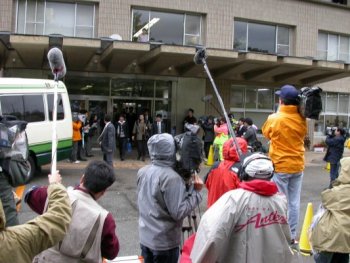 |
Reporters and photographers surround a surviving victim of the North Korean abductions on a homecoming visit to the town office in her native Mano Town in Niigata Prefecture.
|
Initially, the five abductees were supposed to make only a brief homecoming visit to Japan. But their stay was extended, pending developments in the normalization negotiations between the governments of Japan and North Korea. In the meantime, individual media organizations remained unable to make any direct contact with the five survivors. However, during that same period, three Japanese media organizations together conducted a joint interview in Pyongyang with the daughter of one of the abductees that North Korea has said is dead. The families group and the support group harshly criticized those three organizations for what they called the dubious manner in which the interview was arranged and conducted.
The result of these events is that voices in media circles are questioning the usefulness of imposing voluntary restraints on newsgathering activities, even though there is still a broad recognition of the need to prevent media scrums.
(Anxiety over Inability to Confirm Survivors°« True Intentions)
On the day of the surviving abductees°« return to Japan, the victims and their relatives held a joint news conference at the Akasaka Prince Hotel in Tokyo. However, the media were not informed that the victims would appear in person until just before the news conference. Moreover, no questions by reporters were allowed and the five victims walked out of the news conference right after each making a brief address.
The next day, Oct. 16, the relatives of the five victims jointly notified all media organizations that they refused to let the media cover the transfer of the victims to their respective home towns, their former houses, lodging places and nearby areas. The NSK Editorial Affairs Committee in return delivered a request to the relatives, via the city news editors°« council, asking that the media be given an opportunity to have direct contact with the five victims.
On Oct. 17, two of the five victims returned home to Kashiwazaki City in Niigata Prefecture, one to Mano Town in Niigata Prefecture, and the remaining two to Obama City, Fukui Prefecture.
The council of media representatives in each area agreed to restrain their newsgathering activities out of respect for the privacy and human rights of the victims and their families and so as not to inconvenience neighborhood residents. By stipulating specific activities that should be banned, these media councils sought the cooperation of media organizations in the prefectures concerned. For instance, the use of helicopters was prohibited and there would be no chase of the victims, all as part of a massive curb on newsgathering activities that also involved local offices and police.
In the initial stage of the visit, there were no news conferences in which the Japanese families or relatives of the victims spoke about anything that the victims told them. This led media people covering the matter to grow frustrated by their inability to report the news. They wanted to hear from the victims and their relatives about the abductions, as well as to hear the government°«s response, while still recognizing the need for self-restraint.
Later on, families and relatives began to speak about what the victims had said. However, some family members apparently misunderstood the victims°« intentions, the media then reported what the families had said and were ultimately forced to make corrections upon the victims°« protests. The press corps therefore became even more annoyed at the difficulties it faced in accurately grasping the victims°« real intentions.
(Controversial Pyongyang Interview with Kim Hye Gyong by 3 Companies)
On Oct. 24, the Japanese government announced that it would not allow the five victims to return to North Korea and called for North Korea to allow the victims°« families in North Korea to visit Japan for reunions with their parents.
On Oct. 29-30, Japan and North Korea held their first normalization talks in two years at the Japanese embassy in Kuala Lumpur. In those talks, Japan officially demanded that the North Korea-based families of the abductees be allowed to visit Japan. But the negotiations ended without agreement, and the fate of the five victims remained up in the air.
Shortly before those talks, Fuji TV, the Asahi Shimbun and the Mainichi Shimbun conducted a joint interview on Oct. 25 at a Pyongyang hotel with Kim Hye Gyong, 15, the only daughter of Megumi Yokota, one of the Japanese abductees still listed as missing and who North Korea says committed suicide. Fuji TV began to air footage from the interview shortly before 6 p.m. on the same day, and it broadcast a special program on the matter for two hours later in the day. Both the Asahi and the Mainichi carried the details of the interview in their Oct. 26 morning issues.
The families and relatives of the victims criticized the three media organizations for airing and publishing the interview with the girl, saying that it would have a negative influence on the issue of the returnees°« permanent resettlement in Japan. They also asserted that the interview was allowed by North Korea only for its own propaganda purposes, without taking any heed of the girl°«s personal situation. Fuji TV later issued a statement on the matter, and the Asahi and the Mainichi explained in detail the circumstances leading to the interview with the girl.
According to the reports of the two newspapers and the television broadcaster, the girl told them that she could not come to Japan only because her mother was Japanese and that she wanted to meet her Japanese grandparents in North Korea.
The Asahi Shimbun said it conducted the interview as part of its newsgathering activities aimed at bringing to light the truth behind the abductions and at following developments, despite being fully aware of what it said were North Korea°«s motives in permitting the interview with the girl. °»Under severe conditions, we carried out the interview with due heed to the sentiments of the girl herself and her families, and we did our best to report it calmly,°… the Asahi said.
The Mainichi Shimbun said that North Korea°«s diplomatic motivation was apparent. °»In the end, we did our best to report what she said and what facial expressions she made as accurately as possible, while reporting on the background on the North Korean side that led to the authorization of our interview with the girl,°… the Mainichi said.
Fuji TV said in a statement that it had never and would never collaborate with North Korea in the latter°«s propaganda. °»We conducted the interview out of the belief that newsgathering in North Korea is of vital necessity for the unveiling of the truth behind the case of Megumi Yokota (the girl°«s mother), which is at the core of the series of abduction cases, and the interview materialized as part of our various requests for newsgathering activities there. We are engaging in newsgathering activities and broadcasting by fully understanding the sentiment and positions of the victims and their families,°… Fuji TV said.
(Leader of Victims°« Families Group Offers to Meet Media)
Finally, on Oct. 31, Toru Hasuike, secretary general of the Association of Families of Victims Kidnapped by North Korea, announced to the three press clubs at the Tokyo Metropolitan Police Department that in his official capacity, he would accept requests from individual media organizations for interviews and news conferences. At the request of the three press clubs, NSK in turn on Nov. 1 forwarded Hasuike°«s announcement in writing to the members of the NSK subcommittee to prevent media scrums, the city news editors°« council, the media representatives°« liaison council in Niigata Prefecture and other groups, as well as to the National Association of Commercial Broadcasters in Japan and the Japan Magazine Publishers°« Association.
Hasuike decided to respond in his capacity as the secretary general of the families group amid a flood of media requests in the wake of the Japan-North Korea normalization talks. He said in his statement that he had decided to respond to the media requests as the group°«s leader in order to seek the understanding of the Japanese people. However, he said that as a person generally leading his life as a normal citizen, it would be difficult for him to maintain regular relations with the media. He therefore said he would limit his contact with the media to only the times when he would be in Tokyo for his group°«s activities. He also demanded that all of the media requests for contact with him be submitted to a secretary to Kenzo Yoneda, a member of the House of Representatives.
Yet, despite all of these apparent preparations, Japanese media still did not obtain permission for any direct contact with the abduction victims or their families -- with the sole exception of Hasuike himself.
|
|
<< back
|
Nihon Shinbun Kyokai
The Japan Newspaper Publishers & Editors Association
Nippon Press Center Bldg., 2-2-1 Uchisaiwai-cho, Chiyoda-ku,
Tokyo100-8543, Japan
bulletin@pressnet.or.jp.
Copyright 2002 Nihon Shinbun Kyokai
All right reserved
|
|
|
|
